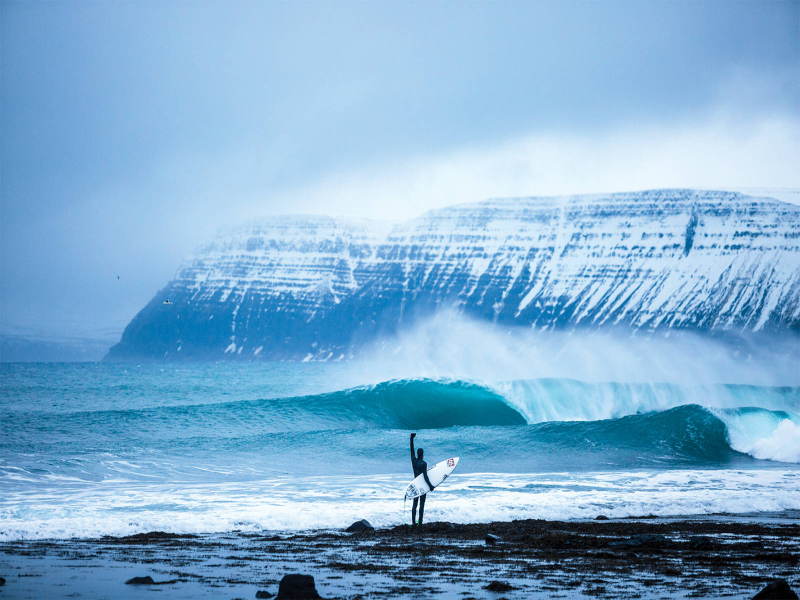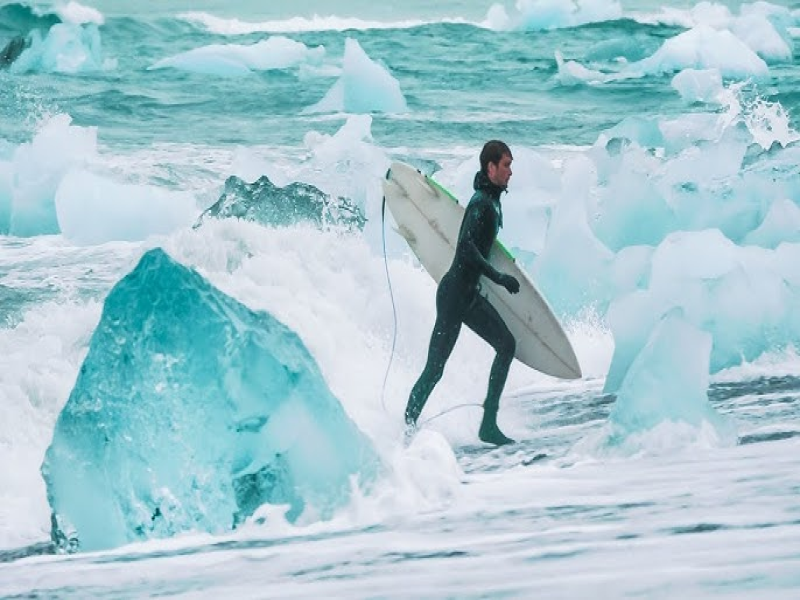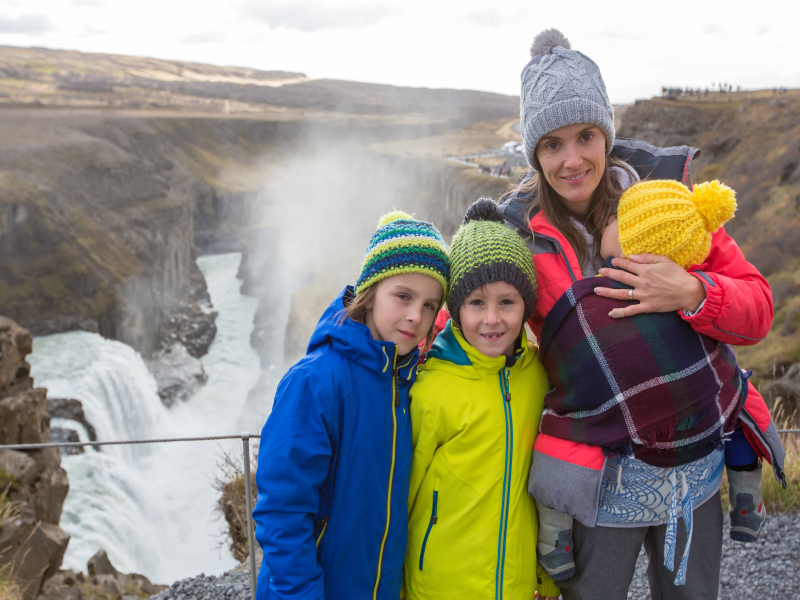Imagine this: you are for example rowing out into the Eastern Atlantic Shaft where the wind is blowing and the air is clearly freezing against your cheek. Here one can observe majestic glaciers flying high, and the condensation of their breath with the salt. Black volcanic sand that crunched under ones feet, this feeling surged after you popped up from the water when surfing a uniquely shaped wave. This is arguably one of the most rewarding forms of surfing – surfing in Iceland; in its raw and powerful nature – unforgettable.
Iceland is the land of fire and ice and people and world travelers are familiar with its tremendous landscapes, hot springs, and beautiful aurora borealis. However, in recent years, it has also turned into an exotic and uncharted spot for surfing among others. Though you may not associate surfing with this country, adventurous souls will find not only the chance to ride thrilling waves away from large crowds, but also first class scenic views of nature vistas.
In this article, you will gain full information regarding surfing in Iceland, including the best time to surf, the ideal locations to surf and more so the appropriate equipment and precautions to take. So wrap up in your thickest wetsuit and go through the challenge that will serve you both, the literal and metaphorical, meaning of breath taking.

Why Surf in Iceland?
It may not be a tropical destination, but Iceland has some interesting things that can interest true surf enthusiasts. Here’s why you should consider catching some waves in the land of fire and ice:
Clean water and less crowds
Forget fighting for waves in a lined-up area. Like many other areas within Iceland, surfing at this break often means that you are the only one there or, at most, accompanied by few other subscriber surfers. It is off the beaten track and only produces high quality waves, the environment is pristine and barren and the focus remains centered on the true beauty of surfing: nature and the waves.
Basically, it is true that Iceland’s coastline provides a wide variety of surfing conditions that provide a variety of waved, from the calm bays with flat water for the beginners to the dangerous reef breaks for the advanced Surfers. Most of the above-mentioned sites lie in secluded bays and on sections of black sand formed by volcanic activity, therefore giving the visitor the thrill of discovery.
Great Landscapes and Geographical Features
You can ride a wave and behind it there is mountain, glacier, or even the aurora borealis in the background. Iceland surfing is a terrific experience for sight, touch, sound, smell and taste because it presents the force of water and the natural majesty of the land mass.
Iceland is one of the most scenically spectacular countries that one can hardly find in the whole world. Waterfall’s trickle from the green slopes, volcanic coast shear off into the ocean, and geothermal fumes apply hellish touch. Surfing during your vacation and cross-country exploration of Iceland is definitely something worth looking forward to.
Feel the Rush – Cold Water Surfing
In this travel destination, the fun is not for the faint hearted and especially surfing in Iceland!!! The water temperatures range between 4-10 degrees centigrade or ideally between 39 degrees Fahrenheit to 50 degrees Fahrenheit all year round, it’s necessary to wear a thick wetsuit and the water can be cold mentally as well. However, for people who take it as a challenge they get some of the most fulfilling moments in surfing in cold water.
Getting thrill from conquering the nature and just surfing the waves in these rather severe surroundings is very inspiring. Besides, you will become a member of an active and enthusiastic group of cold-water surfers who love their sport and nature.
Best Surf Spots in Iceland
Iceland actually has a variety of coastlines which means first-timers will find many beginner beaches to practice on while experienced surfers will enjoy powerful reef breaks. Here are some of the best places to surf in Iceland:
South Coast
- Þorlákshöfn: They highlight a small consistent fishing village with easy-access to a beach break perfect for the over-enthusiastic beginner. The waves that break here are fairly tame and will not rip you to shreds, so it is an ideal place for the novice to begin, or for the seasoned surfer to take an easy morning.
- Grindavík: Accompanied by the famous Geothermal Spa & Beach, Grindavík has got very big waves that only skillful surfers can try. The reef break is harsh here and forms long hollow barrels often making it a stretch for even out of control surfers.
- Vík í Mýrdal: Many visitors will recognize this black sand beach, however less are likely to have tried its fairly tough waves. Here you can sometimes meet some strong waves and it is better for some people to draw attention to the conditions and their health.
Reykjanes Peninsula
- Sandvík: Another exceptional surfing location in Iceland which seems to contain different breaks of various classes, convenient for both amateurs and professionals. At this location, the waves are more constant and better for novices, with more aggressive waves perfect for professionals existing further from the shore at the reef.
- Gunnuhver: A muscular reef break, this wave is not for the amateur to intermediate surfer. Found close to a geothermal zone, Gunnuhver offers very big waves and surfing here is a risky affair even to any experienced surfer. This spot should only be done if the individual is very sure, and knows the conditions around him or her very well.
Westfjords
- Westfjords: Among these, Ísafjörður is quite a pristine area to surf with beautiful nature around. There is also less wind here and the swell is normally much heavier and tricky during winter.
- Bolungarvík: Located in the Westfjords, Bolungarvík has a dependable beach break with stellar views of the mountainous area nearby. It’s also possible for all levels, thus it makes a very nice choice for family or group with beginners and intermediates.
Tip: This specific advice is to remember that it’s always advisable to check the status of the waves through the surf forecast or with any locals before going out on any these spots. Weather in Iceland differs so much and it is convenient to dress appropriately for any type of weather that could be encountered.

When to Go Surfing in Iceland
The time to go for a surf in Iceland is as important as where and with whom you are going to go. When is the best time depends on your experience varied, waves you are interested and chilling temperatures. Here’s a breakdown of the surfing seasons in Iceland:
Surfing Seasons in Iceland
- Winter (October – April): Winter has the most and largest swell in Iceland which makes this a favorite season with core surfers. But do anticipate for cool climates, shorter hours of daylight and in the northern areas there could be snow on some of them.
- Summer (May – September): Summer in Iceland means comparatively less harsh climate and relatively longer day so it is better to surf in Iceland during summers. But the waves are not as wild and as frequent as they are during this time of the year. There is still good surf to be had although the summer surges cannot compare to the winter waves The best surfing is usually done on the south coastline.
Best Time to Surf in Iceland
In terms of wave size and conditions, the shoulder seasons – spring and autumn are usually ideal to ride the waves in Iceland. Indeed, during these months, you could get store fair-sized waves without the cold that comes with winter or the small waves associated with summer.
Here’s a quick table summarizing the pros and cons of each season:
| Season | Wave Size | Weather | Daylight Hours | Pros | Cons |
| Winter | Large | Cold, Icy | Short | Powerful waves, uncrowded breaks | Extremely cold, limited daylight, challenging conditions |
| Spring | Medium | Mild, Variable | Increasing | Good balance of wave size and weather, fewer crowds | Unpredictable weather |
| Summer | Small | Mild, Pleasant | Long | Warmer temperatures, longer days, more comfortable conditions | Smaller waves, more crowds |
| Autumn | Medium | Mild, Variable | Decreasing | Good balance of wave size and weather, fewer crowds | Unpredictable weather |
Ultimately, the best time to surf in Iceland depends on your individual preferences and priorities. Consider your experience level, desired wave size, and tolerance for cold weather when making your decision.
What to Bring for Surfing in Iceland
Surfing in Iceland differs from tropical beaches and requires life vests, hoods and other clothing necessary when thrashing through the cold water. Here’s a checklist of essential items to pack for your surf trip:
A Content Guide: Iceland Surfing Kit
- Thick Wetsuit: Since we’ll be diving in the waters of Iceland, you will definitely need a 5/4mm or even better, 6/5mm wetsuit. Make sure that you get the correct size and that the clothes etc., are not badly worn. And let’s not forget a hood, gloves, and boots for your total thermal protection.
- Surfboard: It might be worth your while to take a slightly thicker board with more volume in it than what you’re ordinarily used to riding on. This will go along way in achieving buoyancy and stability in cold water. Icelandic board is best for a shorter, wider board with a rounded nose to it.
- Leash and Wax: necessarily the same set of basic equipment for surfing; check the state of your leash, and choose cold water wax.
Extra Attire to Wear when Surfing in Cold Water
- Earplugs: Cold water can cause surfer’s ear – a growth of bony ridges in the ear passage – and ear warmers can warn swimmers of this. As for the second and third signs, the use of earplugs can prevent this as well.
- Changing Mat: Since, you’d be changing clothes on the beach you will need a changing mat to keep you warm and dry when putting on or removing your wetsuit.
- Thermals: These are special wear that you can wear underneath the wetsuit to make you warm before and during the water activity.
- Outerwear: You should pack loads of warm clothes other than your wetsuit, a waterproof jacket, fleece and beanie.
Tip: If you’re not planning on using your wetsuit frequently or on travelling too heavy or if you simply want to try out different types of wetsuits many shops in Iceland, including those who offer surf lessons, offer wetsuits for rental.
Tips for Surfing in Iceland
Standing waves in Iceland are different from other countries, therefore searching for a good wave in Iceland needs caution to avoid dangers. Here are some essential tips for surfing in Iceland:
Safety First
- Always knowing the state of the Surf and the climate will do: Always ensure that you check on the forecast before you proceed to the beaches. Sources such as Vedur.is give insights on the height of wave, direction of wind and swell period.
- Network with a Partner: Surfe with a friend If not then at least let someone know your intention. This is especially important in areas that are most likely to take a long time before help is…
- Learn about Risks: Using a hot water tap while in Iceland poses a real danger to the skin. It leads to gasping, hyperventilation and even passing out. Always walk into water and make sure you have the right attire on. Also, beware of the rip currents and other dangers for swimmers.
- Pride and Overconfidence: Do not try surfing big waves which you cannot handle/dodge. However, the waves in Iceland, can be big and nosy, one must not lie to himself/herself and go only for the best waves that suit them.
Respect the Environment
- Looking after our environment: Ensure that you take all the litter you generate into the offing and the beach should be in a better state than it was when you arrived.
- Honor Wildlife: While in Iceland, there are so many types of wildlife such as seal, birds, whales among others.
- Spread the Splash: Some rules regarding how you should or should not behave out in the water. The message to avoid going on someone else’s wave and not to be unaware of one.
Hiring a Guide
For a first timer to surf in Iceland or the other alternative surfing destinations then you might consider hiring a local first. There is nothing wrong with them proceeding to give useful information regarding conditions, surfing customs, and things to avoid. It also might be useful to have a guide for this, who will be able to show you where the best waves for your level are, and generally make sure that the driver and the observer have a good and safe time.
Beyond Surfing: Other Activities in Iceland
Iceland being an amazing country for surfing, don’t limit yourself to only the waves when you are done surfing try out the other ICT attractions. There is plenty to do and see in Iceland no matter what type of traveler you are.
Understanding Natural Geography as a Basis for Iceland’s Attractions
- HIceland Water Worlds: Watch this stunning peek at glaciers and ice caves around Iceland. Hiking or snowshoeing to tour ice caves, glacial hikes, and seeing the ice climbing walls will all be possible.
- Waterfalls: Iceland has numerous waterfall, many of which which may look somewhat similar but have their own attraction. Do not talk behind magnificent waterfalls like Gullfoss, Seljalandsfoss, and Skougafoss.
- Geological Formations – Volcanoes and Hot Springs: Iceland remains one of the few places on the European frontier that has a lot of volcanic activity, you can be taken to view geysers, hot springs and even mud pools.
- Hiking and Biking: There are well marked easy walks for hikers and cyclists as well as strenuous multiday hikes for the more adventurous. Trek through intense terrains such as systematic mountain ranges or plain and broad valleys.
- For those visiting in the winter it might be worth your while to catch a glimpse of the Northern Lights or the Aurora Borealis. The observation is best done with the head facing away from city lights.
Learning More about Iceland
- Cozy Places: The article is dedicated to charming towns and villages of Iceland which may be visited by tourists. The nightlife in Reykjavik is particularly good, but there are also many other cities and towns in Iceland, such as Akureyri and Húsavík that give a more ‘local’ feel.
- Wildlife: For refreshment try Icelandic lamb soup, Smoked salmon and skyr – Icelandic dishes similar to yogurt. Oh yes, you should not hesitate to taste some of the stranger delicacies like the rotten shark or even puffin.
- Discover the subtleties of the cultural heritage of Iceland in the National Museum of Iceland, as well as the Saga Museum.
Tip: This may be a good opportunity to rent a car so, you continue to discover Iceland by yourself. This will provide you good opportunity to find new places and may lead you to places you’ve never been before.

Conclusion
Surfing in Iceland bears all the characteristics of extreme sport. It is an opportunity to get out from the daily grind, to push it to the limit in one of the most elemental and potent ways possible while getting to see some of the most stunning landscapes on the planet. If you are extolled surfer searching for optimum waves for your next riding boards or that year earnest first timer in search of more surfaces to tackle while riding, the waves in Iceland will never leave your memory.
Now ranging from the black sand beach of the south coast to the remote fjords of the west, Iceland has much to offer the surfer of any ability. Experience the cold water which is actually thrilling while enjoying the beautiful Icelandic culture and the nature which encompasses Iceland.
So, what are you waiting for? Fire up the plane reservations to Iceland and get your heaviest wet suit on to catch some waves in the heart of Iceland. It is an unforgettable one.
References
- Surf Report Websites: Magicseaweed, Surfline
- Icelandic Meteorological Office: Vedur.is
- Guide to Surfing in Iceland: GuidetoIceland.is [invalid URL removed]
- Personal experiences and conversations with surfers in Iceland.




